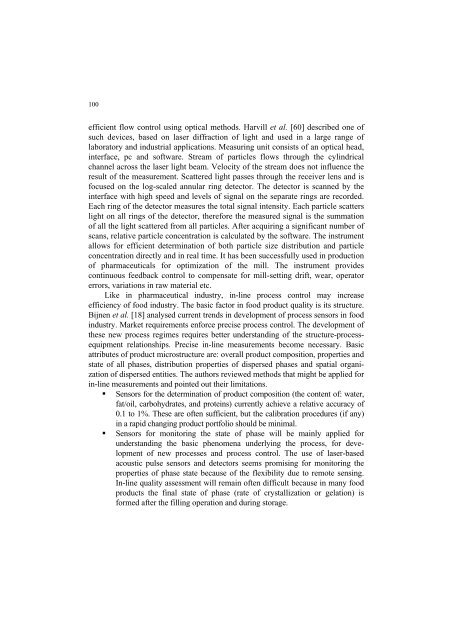Strona 2_redak - Instytut Agrofizyki im. Bohdana DobrzaÅskiego ...
Strona 2_redak - Instytut Agrofizyki im. Bohdana DobrzaÅskiego ...
Strona 2_redak - Instytut Agrofizyki im. Bohdana DobrzaÅskiego ...
Create successful ePaper yourself
Turn your PDF publications into a flip-book with our unique Google optimized e-Paper software.
100<br />
efficient flow control using optical methods. Harvill et al. [60] described one of<br />
such devices, based on laser diffraction of light and used in a large range of<br />
laboratory and industrial applications. Measuring unit consists of an optical head,<br />
interface, pc and software. Stream of particles flows through the cylindrical<br />
channel across the laser light beam. Velocity of the stream does not influence the<br />
result of the measurement. Scattered light passes through the receiver lens and is<br />
focused on the log-scaled annular ring detector. The detector is scanned by the<br />
interface with high speed and levels of signal on the separate rings are recorded.<br />
Each ring of the detector measures the total signal intensity. Each particle scatters<br />
light on all rings of the detector, therefore the measured signal is the summation<br />
of all the light scattered from all particles. After acquiring a significant number of<br />
scans, relative particle concentration is calculated by the software. The instrument<br />
allows for efficient determination of both particle size distribution and particle<br />
concentration directly and in real t<strong>im</strong>e. It has been successfully used in production<br />
of pharmaceuticals for opt<strong>im</strong>ization of the mill. The instrument provides<br />
continuous feedback control to compensate for mill-setting drift, wear, operator<br />
errors, variations in raw material etc.<br />
Like in pharmaceutical industry, in-line process control may increase<br />
efficiency of food industry. The basic factor in food product quality is its structure.<br />
Bijnen et al. [18] analysed current trends in development of process sensors in food<br />
industry. Market requirements enforce precise process control. The development of<br />
these new process reg<strong>im</strong>es requires better understanding of the structure-processequipment<br />
relationships. Precise in-line measurements become necessary. Basic<br />
attributes of product microstructure are: overall product composition, properties and<br />
state of all phases, distribution properties of dispersed phases and spatial organization<br />
of dispersed entities. The authors reviewed methods that might be applied for<br />
in-line measurements and pointed out their l<strong>im</strong>itations.<br />
ƒ Sensors for the determination of product composition (the content of: water,<br />
fat/oil, carbohydrates, and proteins) currently achieve a relative accuracy of<br />
0.1 to 1%. These are often sufficient, but the calibration procedures (if any)<br />
in a rapid changing product portfolio should be min<strong>im</strong>al.<br />
ƒ Sensors for monitoring the state of phase will be mainly applied for<br />
understanding the basic phenomena underlying the process, for development<br />
of new processes and process control. The use of laser-based<br />
acoustic pulse sensors and detectors seems promising for monitoring the<br />
properties of phase state because of the flexibility due to remote sensing.<br />
In-line quality assessment will remain often difficult because in many food<br />
products the final state of phase (rate of crystallization or gelation) is<br />
formed after the filling operation and during storage.
















